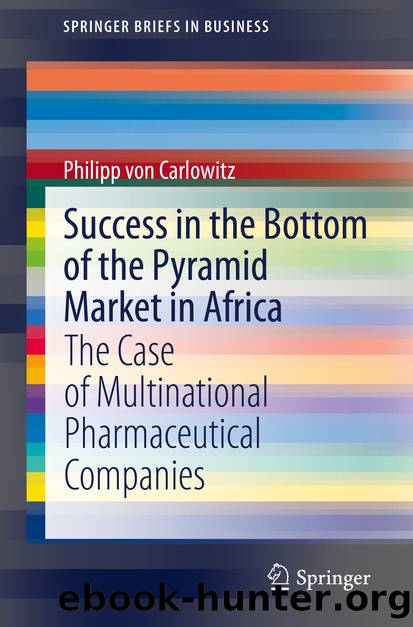Success in the Bottom of the Pyramid Market in Africa by Philipp von Carlowitz

Author:Philipp von Carlowitz
Language: eng
Format: epub
ISBN: 9783030590680
Publisher: Springer International Publishing
Looking at the economic structure over time an economic transformation can be observed for the four SSA regions. It is visible in the percentage change of the sectorsâ value added in total value added (constant USD) as shown in Fig. 4.4.
Fig. 4.4Structural economic transformation by SSA regions 2000â2017 (percentage points difference in shares of sector value added in GDP between 2000 and 2017, constant USD). Source: Own Illustration, based on UNCTAD (n.d.-c), National Account Statistics
It appears that SSA is embarking on a new type of economic transformation path, shifting from primary industries (agriculture, mining) to service-based industries, structurally bypassing the manufacturing sector. Looking at manufacturing the result is very differentiated with the relative share of manufacturing in East and Southern Africa falling while stagnating in the other two regions. This has economic and social implications as manufacturing industries are usually (lower skilled) employment-intensive. With regard to agriculture, the development is different. Its share is shrinking everywhere except in West Africa while that of the service sector is increasing. The most distinct shift away from agriculture is seen in East Africa. Turning to mining, the strongest shift from mining to services is observed in West Africa. This has significantly reduced the strong direct and indirect dependency of GDP on commodity prices in many African countries. Nigeria, for instance, has started on a diversification process, moving away from its strong dependency on mining to a stronger service orientation7 with the share of oil in GDP dropping from over 25% in 2000 to only 10% in 2016 (AfDB et al. 2017). Interestingly and contrary to common understanding, the share of mining and utilities in Western Africa is declining not only because of the weak performance of the mining sector (it grew by just over 3% p.a. between 2000 and 2017) but because of even higher growth in manufacturing and the service industries, all above 6% p.a. (UNCTAD n.d.-b). It will, however, be many years before dependency on commodities is significantly reduced, especially when indirect effects related to foreign exchange earnings and tax revenues are included: The former reduces the import potential of needed goods, and the latter limits government revenue and, ultimately, public spending.
FDI inflows facilitate this structured transformation. Looking at FDI project numbers, the majority of the total 718 projects is found in the service industries such as transportation (41), business services (80), software/IT services (53), financial services (67), and communication (45). Of these, all grew except financial services (â44%) and business services (â22%). Turning to FDI projects by business activities, most are related to manufacturing, sales and marketing, and business services (Analyze Africa 2017). FDI activity by value into Africa declined between 2012 and 2017 but recoveredâagainst the global trend (â27%)âin 2018, growing by 11% to a total inflow of USD 46 bn. Of this USD 32 bn went to SSA. Despite SSAâs low global share in FDI inflow in 2018 (2.5% of world FDI share), it plays a significant role in the economic development of Sub-Saharan African countries. FDI accounted for 1.
Download
This site does not store any files on its server. We only index and link to content provided by other sites. Please contact the content providers to delete copyright contents if any and email us, we'll remove relevant links or contents immediately.
The Fifteen Biggest Lies about the Economy: And Everything Else the Right Doesn't Want You to Know about Taxes, Jobs, and Corporate America by Joshua Holland(1086)
The Economist (20210109) by calibre(895)
The World For Sale by Javier Blas(821)
Made in China by Anna Qu(810)
Philippines--Culture Smart! by Culture Smart!(669)
Boom and bust a global history of financial bubbles by Quinn William Turner John(656)
Mission Economy by Mariana Mazzucato(654)
Forex Trading All In One For Dummies by Mishra Mamta(640)
Big Money by Kenneth P. Vogel(622)
The Money Revolution by Anne Boden(618)
The Dictatorship of Woke Capital by Stephen R. Soukup(614)
The New Retirement Savings Time Bomb by Ed Slott(602)
Tax the Rich! by Morris Pearl(598)
Cross Winds: Adventure and Entrepreneurship in the Russian Far East by Myers Steven(591)
The Inflation Myth and the Wonderful World of Deflation by Mark Mobius(585)
Fundamentals of Finance by Mustafa Akan Arman Teksin Tevfik(562)
The Great Demographic Reversal by Charles Goodhart & Manoj Pradhan(553)
European Yearbook of International Economic Law 2017 by Marc Bungenberg Markus Krajewski Christian Tams Jörg Philipp Terhechte & Andreas R. Ziegler(549)
Business Recoded by Peter Fisk(541)
